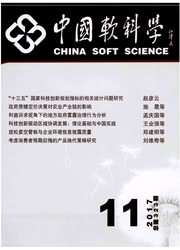

 中文摘要:
中文摘要:
利用我国2005-2007年30万家工业企业数据,对工业企业研发投入分布特征进行描述性统计得到:我国仅10%左右的企业有研发活动,在从事研发活动的企业中49.25%的企业研发活动不稳定;年销售收入大于3亿元的特大型企业,其研究开发经费占销售收入的比重也只有0.52%;研发投入产业分布具有明显重型化工业结构特征、地区分布不均衡;政府引导企业研发投入的特征明显;大规模、寿命期长的企业从事研发活动的比例高、研发投入总量大,但研发投入强度反而更低;研发投入集中度较高,约1/4的研发投入集中在有研发投资活动的3%的企业里,研发投资还没有成为一般企业的自主行为。对企业研发强度的影响因素分析得到:第一,企业规模、年龄等内部因素显著正向影响研发投入总量,但显著负向影响研发投资强度,企业规模与"研发投资/总资产"表示的研发投入强度之间存在"倒U"型关系。企业利润显著正向影响私营企业和外资企业的研发投资强度,但对国有企业影响不显著;第二,地区财政的科技支持、银行信贷资金支持显著提高了不同经济类型企业的研发投入强度,但对国有企业的作用大大超过私营企业和外资企业。中国本土企业的创新投入存在两难:国有企业的研发投入规模大、强度高,主要来源于财政和信贷支持,企业缺乏内生的激励与资金来源;私营企业创新投入有内生激励,但缺乏政府财政支持、尤其信贷大力支持。
 英文摘要:
英文摘要:
Using 300 thousand industrial enterprises’ panel data from 2005 to 2007 in China,this paper analyzed the distribution of R&D investment and influences of R&D intensity.The descriptive statistics brought the following conclusions.Only 10% of enterprises take R&D investment and 45.25% of firms’ R&D activity isn’t stable.For Large enterprises whose annual revenue of sales is more than 30 million yuan,R&D intensity measured by the ration of R&D investment to gross sales is only 0.52%.Industrial distribution of firms’ R&D investment reflects the features of heavy-industrialization in China.R&D investment varies from provinces.R&D investment taken by state-owned enterprises(SOEs) makes up 45.6% of the total R&D investment.Bigger and older Firms are more likely to be involved in R&D activity and take a larger amount of R&D investment,but a lower R&D intensity.The concentration of R&D investment is very high.About a quarter of R&D investment is taken by 3% of firms,general firms have not taken R&D investment initiatively.By the analysis of R&D investment’s influences,we got the following conclusions.First,firm’s size and age are positive correlated with the amount of R&D investment,but negative with R&D intensity.R&D intensity measured by the ration of R&D investment to total asset shows a reverse-U relationship with firm’s scale.R&D intensity is positively influenced by profit for privately-owned enterprises and foreign-owned enterprises.But this influence is not significant for SOEs.Second,bank loans and fiscal support to science & technology greatly improved R&D intensity.However,the effect on SOEs is higher than privately-owned enterprises.China’s innovation investment is trapped in a dilemma.On one hand,SOEs lack intrinsic motivations to take R&D investment and its high R&D intensity mainly benefits from financial support.On the other hand,privately-owned firms have incentives to take R&D investment,but lack financial support.
 同期刊论文项目
同期刊论文项目
 同项目期刊论文
同项目期刊论文
 The Relation between Eternal Governance Environment and Over-investment: Evidence from Industry Regu
The Relation between Eternal Governance Environment and Over-investment: Evidence from Industry Regu The relation between external governance environment and over-investment: evidencefrom industry regu
The relation between external governance environment and over-investment: evidencefrom industry regu Institutional environment and overinvestment in emerging markets-empirical evidence from Chinese lis
Institutional environment and overinvestment in emerging markets-empirical evidence from Chinese lis 期刊信息
期刊信息
